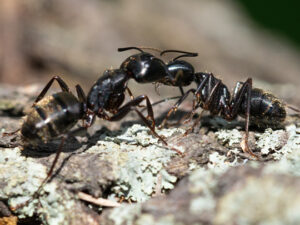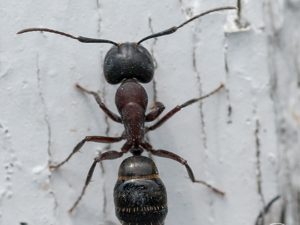
Ant infestations are an unwelcome surprise for any homeowner, and different species can pose various challenges. Identifying and understanding the behavior of common ant species in the Buffalo, Syracuse, and Rochester areas is the first step to controlling and preventing infestations. This comprehensive guide is designed to help you navigate the nuances of these tiny invaders, equip you with the knowledge to take action, and ensure that your home is ant-free.
Why Identifying Ant Species is Crucial for Effective Pest Control
Not all ants are created equal, and the same control method may not work for all species. Different ants have different feeding habits, nesting behaviors, and responses to remedies. Pinpointing which ant species you’re dealing with is essential for targeting the infestation. Here, we’ll delve into the characteristics of the most common ant species in your area.
The Pavement Ant (Tetramorium caespitum)
Pavement ants are typically found in urban environments and under sidewalks, building blocks or concrete slabs. They are small, dark brown to black, and often invade regions bordering sandy soil. These ants enjoy a diet that includes protein and sweet items, making them quite varied in their food-seeking habits. Their colonies can reach substantial sizes, with multiple queens.
The Carpenter Ant (Camponotus sp.)
Distinguished by their propensity to hollow out wood for nesting, carpenter ants are significant excavators. Their presence can be a major issue for the structural integrity of your home, particularly if they take a liking to moist or decaying wood. These ants vary greatly in size, from small workers to large queens and even larger soldiers.
The Odorous House Ant (Tapinoma sessile)
Also called the “sugar ant,” odorous house ants are known for their distinct, unpleasant odor when crushed. These ants are small and dark brown and are attracted to sweet foods, often found trailing along kitchen countertops. Their nesting sites vary and can be found both indoors and outdoors.
The Red Imported Fire Ant (Solenopsis invicta)
This species is a newer, more aggressive invader of the New York area. It is small and reddish-brown in color, and nests in large, dome-shaped mounds. Fire ants are known for their painful stings and are not typically found indoors, though they can venture inside in search of food.
Location, Location, Location: Where Do Ants Lurk in Your Home?
Ants are experts at finding their way into our living spaces, and it’s helpful to know where different species tend to nest or frequent.
Nesting Habits of Ants
Ant nesting sites can vary widely. While some prefer the persistent humidity of your bathroom, others may seek out the warmth of your kitchen appliances. Understanding the nesting habits of the ant species in your area can help you efficiently target potential colonies.
Common Indoor Hotspots
For many ant species, the indoors offers a fertile ground for food and shelter. Kitchens, bathrooms, and other moist areas are common places to find foragers. Identifying these key areas can streamline your control efforts.
Outdoor Haunts
Outdoor areas around your home, especially those with easy access to entry points, are prime territories for ants. Tracking their trails can often lead you to their outdoor nesting sites. Mulch, woodpiles, and garbage storage areas are magnets for these tiny pests.
DIY vs. Professional Pest Control: When to Call in the Experts
While DIY ant control methods can be effective for small infestations, sometimes professional intervention is necessary to fully eradicate the problem.
DIY Ant Control Tactics
Simple steps can include keeping all surfaces clean, storing food in airtight containers, sealing entry points, and using household ant baits. These tactics can prevent some infestations and control minor ones.
When Pest Control Professionals Are Essential
It’s time to reach out to the professionals when DIY efforts fail, and the infestation continues or seems overwhelming. Pest control experts have the knowledge, tools, and experience to identify, treat, and prevent ant problems effectively and safely.
Benefits of Professional Pest Control
Professional pest control services offer a range of benefits, including comprehensive inspections, tailored treatment plans, ongoing preventive measures, and advice on home maintenance to reduce the risk of future infestations.
Integrated Pest Management (IPM): A Holistic Approach to Ant Control
IPM is a sustainable approach to managing pests by combining biological, cultural, mechanical, and chemical tools in a way that minimizes economic, health, and environmental risks.
Biological Control
In some cases, introducing beneficial organisms or predators can help control ant populations without resorting to chemicals. This approach should be carefully considered to avoid unintended consequences.
Mechanical Control
Simple physical barriers, such as blocking entry points and trapping, can be highly effective against ants. Exclusion methods can help keep your home ant-free.
Chemical Control
When other methods are not practical or effective, chemical control using pesticides is an option. However, always use caution, read labels carefully, and consider the risks to humans, pets, and the environment.
Preventing Ant Infestations: Proactive Measures for a Pest-Free Home
The best way to deal with an ant problem is to prevent it from happening in the first place. Adopting some proactive measures can significantly reduce the likelihood of an infestation.
Home Maintenance for Ant Prevention
Seal cracks and crevices, fix leaks, clear clutter, and keep your home clean. Regular maintenance can dissuade ants from seeing your home as a viable option.
Outdoor Ant Prevention
Maintain your yard, remove potential nesting sites, and keep outdoor areas clean. Properly stored garbage, sealed compost bins, and keeping mulch away from the home’s foundation can help ward off outdoor ant populations.
Treating High-Risk Areas
Targeting high-risk areas with preventive measures, such as spot treatments or ant barriers, can provide an additional layer of defense against invading ant colonies.
When It’s Ant Season: Yearly Cycles and Infestation Patterns
Ant activity can follow seasonal patterns, with some species becoming more active at certain times of the year. Understanding these cycles can help you anticipate and prevent infestations before they occur.
Spring and Summer Months: Peak Activity
Warmer months are typically when ant activity peaks, as the warmer temperatures encourage their foraging and reproductive behaviors. This is a critical time for preventive measures and control tactics.
Fall and Winter Months: Preparing for Dormancy
Colder weather often drives ants indoors to seek warmth and shelter. Preparing your home for this change in behavior can prevent a winter infestation.
Year-Round Vigilance: Consistent Monitoring and Control
Ants can be persistent, so consistent monitoring and control measures are essential even during their apparent “off” seasons.
Town and Country Pest Solutions: Your Ally in the Battle Against Ants
At Town and Country Pest Solutions, we understand the frustration of dealing with ants. Our expert technicians provide targeted solutions that are safe for your family and the environment.
Comprehensive Ant Inspections
Our technicians are trained to identify ants and their entry points, nesting sites, and behaviors. This in-depth knowledge allows us to develop a precise plan for your home.
Tailored Ant Control Plans
We don’t believe in one-size-fits-all solutions. Your ant control plan will be customized to your specific situation, using the most effective methods available.
Ongoing Ant Prevention
We go beyond just controlling the current infestation. Our goal is to help you prevent future issues with our integrated pest management techniques, ensuring a pest-free home year-round.
Conclusion: The Power of Knowledge in Ant Control
As a homeowner, knowledge is your most powerful ally in the fight against ant infestations. By understanding the species in your area, their habits, and effective control methods, you can take charge of the situation. Remember, for persistent or overwhelming infestations, professional pest control is your best recourse.
With this guide, you’re now equipped to tackle ant problems head-on. Stay vigilant, be proactive, and never hesitate to call in the experts when needed. Your home should be a sanctuary — let Town and Country Pest Solutions help you keep it that way.











